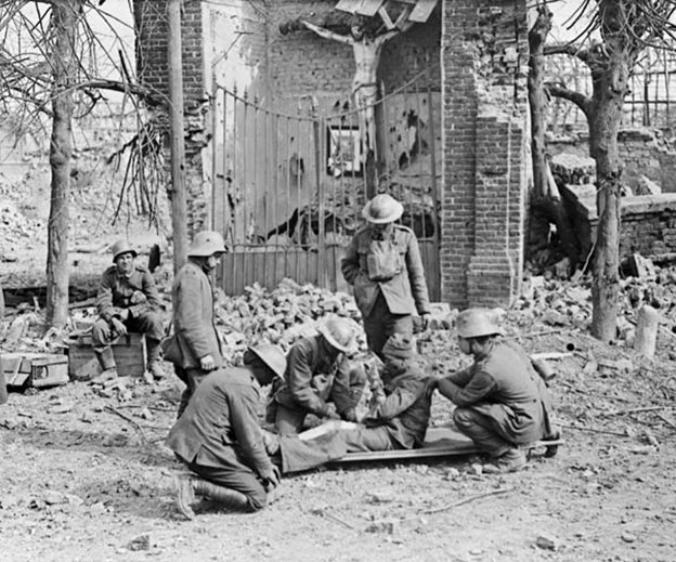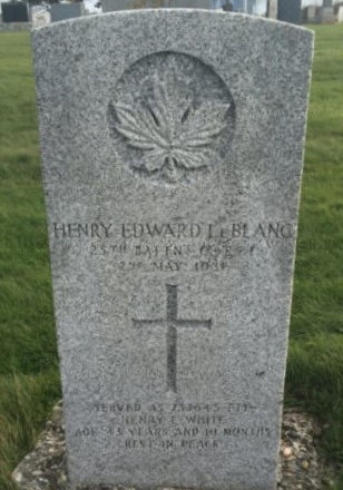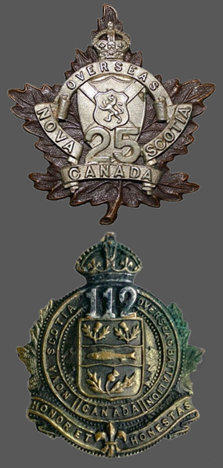
copyright © Wartime Heritage Association
Website hosting courtesy of Register.com - a web.com company
Wartime Heritage
ASSOCIATION
Remembering World War I
Yarmouth Connections
Name:
Henry Edward White
Rank:
Private
Service Number:
733645
Service:
112th Battalion, 25th Battalion,
Canadian Expeditionary Forces
Awards:
British War Medal 1914-1920,
Victory Medal 1914-1919, 1 Gold Bar
Date of Birth:
July 27, 1887
Place of Birth:
Yarmouth, Yarmouth Co., Nova Scotia
Date of Enlistment:
February 15, 1916
Place of Enlistment:
Yarmouth, Yarmouth Co., Nova Scotia
Age at Enlistment:
28
Address at Enlistment:
Yarmouth North, Yarmouth Co., Nova Scotia
Previous Military Service:
29th Battery, Canadian Field Artillery
Height:
5 feet, 7 inches
Complexion:
Dark
Eye Colour:
Brown
Hair Colour:
Black
Occupation:
Farmer
Marital Status:
Married
Religion:
Roman Catholic
Next of Kin:
Mary White (Wife), Yarmouth North, Nova Scotia
Date of Discharge:
July 31, 1918
Age:
31
Date of Death:
May 2, 1931
Age:
44
Cemetery:
Our Lady of Calvary Roman Catholic Cemetery, Yarmouth, Nova Scotia
Henry Edward White was the son of Edward White (b. 1849) and Frances White (b. 1848). He was the
husband of Mary (Deveau) White (b. 1892) and the father of George Alfred White (b. 1911), Henry
Edward ‘Harry’ White (b. 1913), and Mary Elizabeth White (b 1914). Edward and Mary (daughter of
Frank and Collette Deveau) married February 7, 1911, in Yarmouth, Nova Scotia. Edward’s surname is
recorded as ‘LeBlanc’ on his marriage record and on his grave headstone. Other records list his
surname as ‘White’.
Edward was working at the Cotton Mill in 1901 at the age of 15 or 16, where he also worked post-war.
After enlisting in February 1916, Henry trained in Canada in the spring and summer of 1916, and
embarked in Halifax for the UK on July 23, 1916. He arrived in Liverpool, England on July 31, 1916,
aboard the SS Olympic.
He joined the 25th Battalion in the field in France on October 22, 1916. He was taken out of the line
and transferred from his unit to the No. 5 Canadian Field Ambulance on Jan 13, 1917, with influenza.
He rejoined his unit twelve days later Jan 25, 1917.
3 months later, Edward and the 25th Battalion took part in the Battle of Vimy Ridge in April. After
Vimy, the Canadians then began to push forward, taking out various outposts and advancing over the
course of two weeks until mid-April. At that point, they met a larger amount of German resistance.
The village of Arleux-en-Gohelle was the next big objective in the Arras Offensive. The Arleux Loop
was part of a system of German defences that encompassed the village of Arleux-en-Gohelle. The
system was fortified with concrete, belts of wire and a large amount of machine guns. Hoping to blast
through this offensive, General Haig ordered a four-battalion attack by the Canadians on the Arleux
Loop at Arleux-en-Gohelle. The battalions assigned to take part in the attack was the Western Cavalry,
the Winnipeg Rifles, the Canadians, and the Nova Scotia Rifles; known respectively as the Fifth,
Eighth, 10th and 25th Battalions.
The main attack was launched at approximately 4 am on April 28, 1917, after a major artillery
barrage. Edward suffered a gun shrapnel wound to the forehead on April 28, 1917 (and awarded 1 gold
bar in the field) during the Battle of Arleux.
Robert Lester Goodwin and Frank Kinney of Yarmouth County were killed in action the same day on
April 28, 1917, during the Battle of Arleux. Six other men with ties to Yarmouth County were killed on
the next day of the fighting on April 29, 1917 – Merton H. Goodwin, Carl Hemeon, Eugene Lewis,
Harold T. Long, John Alfred Muise, and Gordon S. Murree.
Edward was transferred to the 3rd Canadian General Hospital in Boulogne, France on April 30th and on
May 1, he was invalided to the Nova Scotia Regiment Depot Battalion at Bramshott. He was at Military
Hospital Chatham on May 2nd, and the Canadian Convalescent Hospital at Epsom, Surrey, on May 9th.
He was transferred to the Ontario Military Hospital in Orpington, South East England on June 12, 1917,
suspecting of having TB in his lungs.
Once this was determined, it was decided he should be transferred to Canada for further treatment.
Private Henry Edward White returned to Canada aboard the HMHS Araguaya (His Majesty’s Hospital
Ship) on October 17, 1917, arriving in Halifax on the 27th.
He was admitted to Camp Hill Military Hospital in Halifax, in November 1917, December 1917, and
January 1918 attempting to address his tuberculosis.
He was discharged July 31, 1918, being found medically unfit for further service having suffered from
tuberculosis (TB).
Henry's Canadian military service records from
Library Archives of Canada confirms his illness
originated from his military service. His file
records he contracted TB whilst in service to the
country and suffered from it post-war, resulting
in his death.
He died on May 2, 1931, and is interred at the
Our Lady of Calvary Roman Catholic Cemetery in
Yarmouth, Nova Scotia.
Henry Edward White


A stretcher-bearer and German prisoner tend to a Canadian wounded at Arleux. Note the crucifix in the
background – one of few shelters left standing in the village. Credit: Canada. Dept. of National Defence/Library
and Archives Canada/PA-00136




- World War I - Menu
- WWI Stories and Articles
- Photos - Yarmouth Soldiers
- Selection of World War I Songs
- WWI Casualties of Yarmouth, NS
- Those Who Served - Yarmouth, NS
- WWI Casualties Digby Co. NS
- WWI Casualties Shelburne Co. NS
- Merchant Mariners (1915) Yarmouth, NS
- Canadian Forestry Corps - Non Yarmouth Birth/Residence Enlistments
- US Draft Registry - Yarmouth NS Born


- World War II - Menu
- WWII Stories and Articles
- Telegraphist Air Gunners
- WWII Casualties of Nova Scotia
- US Casualties with NS Connection
- Far East/Pacific Casualties with NS Connection
- Merchant Navy Casualties Nova Scotia
- Nova Scotia WWII Casualties Holten Canadian War Cemetery
- D-Day Casualties - Nova Scotia
- CANLOAN Program Casualties - Nova Scotia
- Battle of the Bulge Casualties - Nova Scotia
- WWII Casualties Yarmouth NS
- Yarmouth Casualties - RCAF RAF Canadian Army WWII
- Yarmouth Co., Marriages WWII
- Casualties Non-Born/Residents with Connection to Yarmouth Co., Nova Scotia.
- WWII Casualties Digby Co., NS
- Non-Nova Scotian WWII Casualties Buried in Nova Scotia
- WWII RCAF Casualties Aged 16-18
- Brothers/Sisters Who Served - World War II














